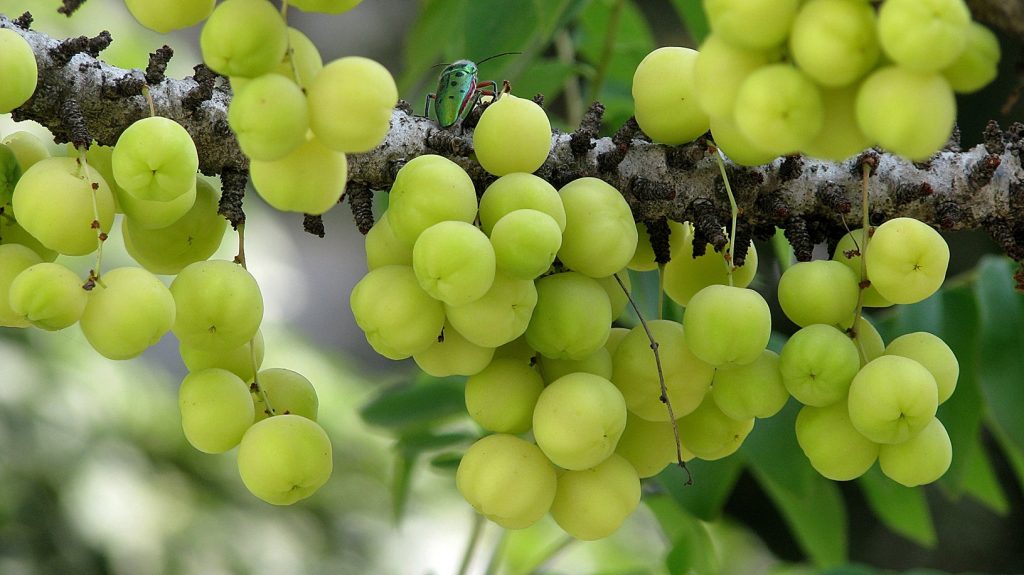
Amalaki / Emblica Officinalis
- July 31, 2020
- Posted by Dr. Vaidya Karanvir Singh
- 0 Comment(s)
Botanical Classification (Taxonomy)
Latin Name- Emblica Officinalis
Family- Phyllanthaceae
English Name- Indian Gooseberry, Malacca Tree, and Emblic Myrobalan,
Hindi Name- Amla
Sanskrit Name- Amalaki, Amalika, Dhatri, Dhatriphala, Sriphalam, Vayastha, Aonla, Vrushya,
Kingdom- Plantae
Sub-Kingdom- Viridiplantae
Infra Kingdom- Streptophyta
Super Division- Embryophyta
Class- Magnoliopsida
Genus- Phyllanthus L. (Leaf Flower)
Species- Phyllanthus Emblica (Emblic)
Division- Tracheophyta/ Tracheophytes
Sub Division- Spermatophytina/Spermatophytes (Seed Plants)
Super Order- Rosanne
Order- Malpighiales
Amla is also known as “Indian gooseberry” and it is rich in nutrients. It is the richest source of vitamin C. It improves digestive power and relieves acidity. It is also good for diabetic patients as it controls blood glucose levels. It has been used in Ayurveda as a Rasayanic tonic for many ages that helps to brighten the skin, purify the blood, and improve eyesight naturally.
Names in different languages:
English name: Indian Gooseberry
Hindi name: Ambala, Awla, Amlika, Amla, Anwala
Punjabi name: Ambul, Ambalo, Aamlaa
Kannada name: Bettada Nelli Kayi
Telugu name: Nellikaay, Nellikkali, Perunelli
Farsi name: Amlaj
Malayalam name: Nelli
Urdu name: Amal khushk, Aamla
Bengali name: Amla, Aamla, Aamro and Aamalaki
Arabic name: Amlakhushk
Manipuri name: Heikru
Marathi name: Avalkati, Avil, Avka, and Aouli
Assamese name: Amlokhi, Amlaki, Amlok, Amla
Konkani name: Avalo
Kannada name: Nellikay Nelli
Its Sanskrit synonyms:
Sheetaphala- It has a coolant property
Vayastha, Vayasya- It has anti-aging property
Dhatri- It takes care of the patient as a mother
Divya, Shriphala- Its fruit is auspicious
Amrutaphala- As good as the nectar
Other synonyms are- Seeduphala, Shivam, Shanta, Jatiphalarasam Seedurasa, Vrishyaphala, Varshaphala, Shanta, etc.
Ayurvedic Properties
- Rasa (Taste)- Sour Taste is the dominant and other 4 tastes are present except saline taste – Madhura (Sweet), Amal (Sour), Tikta (Bitter), Katu (Pungent), and Kasaya (Astringent)
- Guna- Guru (Heavy), Sheeta (Cool) and Ruksha (Dry)
- Virya (Potency-Sheeta (Cold)
- Vipaka (Resultant)- Madhura (Sweet)
- Therapeutic Effect – Prabhava (Rejuvenation)
- Dosha Karma (Effect on Humor)- Amla pacifies mainly Pitta, but it also alleviates the Kapha and Vata.
- Dhatu (Effect on tissues)- Rasa, Rakta, Medas and Shukra dhatu
What are the therapeutic benefits of amalaki?
- Kanthya- It is useful in throat related diseases and improves voice
- Hrudya- It is good for the heart
- Daahahara- It treats burning sensation
- Rasayana- It has rejuvenative and anti-aging property
- Vrushya- Aphrodisiac
- Javarahara- It is used in fever
- Premhaghna- It is used in diabetes mellitus and urine related issues
- Raktapittaghna- It is used in blood-related disorders
- Chakshushya- It improves vision and also good for eyes
- Vayasthapana- It has an anti-aging action
What are the therapeutic uses of Amalaki?
Here are the therapeutic uses of amalaki-
Amla (Indian Gooseberry) shows anti-hyperglycemic effects on the body. It has no side effects. In diabetes mellitus, this extract of fruit interferes with the absorption of glucose in the gut and stops the entry of glucose in the blood. It balances the blood glucose levels post-meal and delays the digestion of glucose.
Osteoporosis
It is the richest source of Vitamin C and is recognized as one of the essential nutrients for the prevention and treatment of osteoporosis. It keeps the bones healthy and strong and also improves the absorption of the minerals and increases bone mineral density. In Ayurvedic Medicine, Amla can be used along with Ashwagandha, Arjuna, and other Ayurvedic mineral medicines to improve bone strength. It also increases bone mineral density.
Anemia
Amla is an anti-anemic fruit that has iron and vitamin C present in it. It helps in the better absorption of the iron because it contains ascorbic acid that enhances the iron absorption. It also increases the hemoglobin levels in the body.
Peptic Ulcers
In Peptic Ulcers, it shows very good results by working on reducing the production of acid in the stomach. Its antioxidant action helps to protect the gastric mucosa from any damage and also prevents the ulceration. Various complications of peptic ulcers such as gastric carcinoma will also be treated with it and also the symptoms like pain in the abdomen, weight loss, poor appetite, nausea, and vomiting.
Gastritis
This fruit has a natural antacid property that provides relief from the symptoms of gastritis. It controls the acidic production in the stomach and reduces abdominal pain, nausea, vomiting, and heartburn, etc due to the hyperacidity.

Dr. Vaidya Karanvir Singh is the younger Vaidya in Chandigarh Ayurved & Panchakarma Centre. He is the fourth generation in his family who is practicing as a general consultant in Ayurved & Panchakarma treatment at Chandigarh. In his practice, he had treated more than 1 Lakh Plus patients worldwide.

